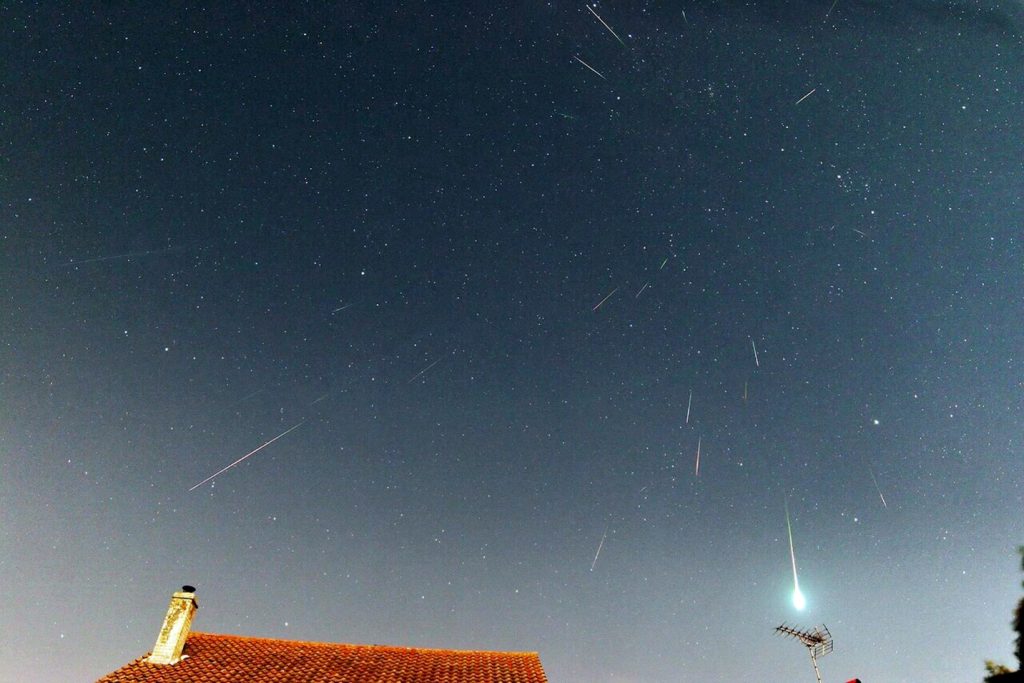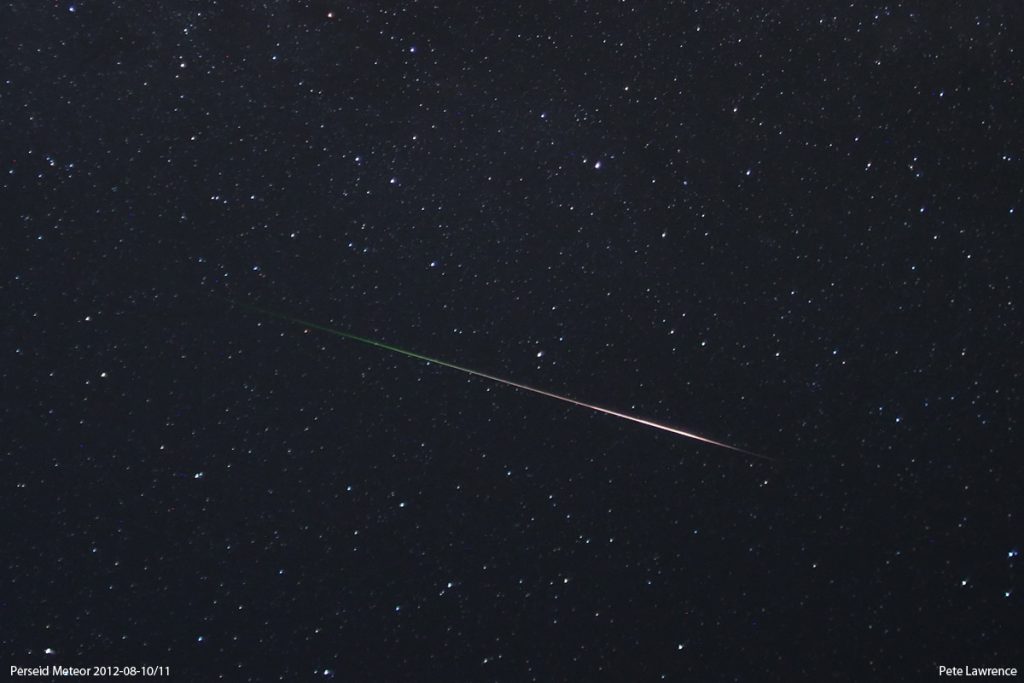2023 August 3
A Great Year for the Perseid Meteor Shower!
With the August Full Sturgeon Moon behind us, the Moon is now rising slightly later each night providing observers with the darker skies needed to enjoy the rising activity of the annual Perseid meteor shower. Always the summer’s main attraction for meteor enthusiasts and casual observers alike, the Perseid meteor shower is expected to peak this year between 07h and 10h UT (08h and 11h BST) on Sunday, August 13, making the entire weekend from the evening of Friday, August 11 through to the early morning hours of Monday, August 14 the most productive time for observers in the UK since the peak is quite broad.
The really good news is that there will be no interference from moonlight during the period of maximum activity this year, with Last Quarter occurring on August 8 and New Moon on August 16. Consequently, watches carried out during this time are likely to yield good observed rates. Let’s hope the weather cooperates for this weekend feast of meteor activity!
The shower is associated with the stream of dusty debris strewn along the orbit of periodic comet 109P/Swift-Tuttle. The comet was independently discovered by Lewis Swift and Horace Tuttle in July 1862 and we now know that there are historical records of the comet in 69 BCE and 188 CE. It was also observed by Ignatius Kegler in July 1737. The comet’s nucleus is quite large, having a diameter of about 25km. The comet was last seen in 1992 and won’t be back again until 2126, but dust grains from the comet can be seen every year as they burn up in the Earth’s atmosphere as members of the Perseid shower.

Meteors streaking out from the radiant in the constellation of Perseus at the height of the annual Perseid meteor shower. Image courtesy of Pete Lawrence.
The name arises from the fact that at its peak meteors from this shower all appear to radiate outwards from a small region of the sky (known as the radiant) in the constellation of Perseus. In ancient times they were called ‘The Tears of St. Lawrence’. The Perseids are one of the most reliable meteor showers of the year, producing an abundance of fast, bright meteors, many with persistent trains.
When to observe
Perseid meteors are detected as early as late July/beginning of August and until about August 21. There is a noticeable ‘uptick’ in the shower’s activity around August 8-9. Steadily increasing observed rates can be expected in dark skies from this date until the peak on August 12-13, with the best observed rates expected in the early morning hours of Sunday, August 13. It is hoped that, weather permitting, observers will cover shower activity even on nights away from the maximum, for example on the Friday night to Saturday morning (August 11-12) and Sunday night to Monday morning (August 13-14).
Observers watching after midnight on August 12-13 should experience increasing activity towards dawn, as the shower radiant at RA 03h 11m, Dec. +58°, near the Double Cluster, on the Perseus-Cassiopeia border, climbs higher in the eastern sky. There should also be good activity as darkness falls on both August 12-13 and Aug 13-14, although the radiant will be relatively low in the north-east at this time. Although few in number, Perseids seen when the radiant is low will last longer and travel a much greater distance across the sky than those observed in the early morning hours. Some of these ‘earth-grazing’ Perseids can be spectacular if they happen to pass more or less overhead.

A Perseid meteor streaking across the summer night sky. Dust grains from the Perseid shower hit Earth’s atmosphere at a speed of 58.6 km/sec – that’s about 131,000 mph! Image courtesy of Pete Lawrence.
Observed Perseid rates improve as the radiant altitude increases from 27° at 21h, to 43° at midnight and 66° by 03h. All else being equal, the best observed rates are found when the Perseid radiant is highest in the sky during the pre-dawn hours. Under cloudless skies, and in a dark viewing site, observers can expect to see between 50 and 70 meteors each hour near the peak. Even in light polluted towns or cities observed rates may still be around ten an hour in the early morning hours when the radiant is high. It doesn’t matter in which direction you look, because Perseids may be seen in any part of the sky. Near the radiant the trails will tend to be short, whereas on the other side of the sky the meteors will appear as streaks with long paths.
Visual observing
While watching the Perseid shower this year we would encourage you to contribute useful data to the BAA by simply counting the number of meteors seen during a specific time range and sending your counts to us. Watches should ideally be of an hour’s duration or longer (in multiples of 30 minutes) because this will tend to even out the varying intervals between individual meteors. You might see no meteors at all for 10 minutes and then see three in the space of a minute! Perseids will all appear to originate from the radiant (if you extend their paths backwards) no matter where in the sky you see them. However, some of the meteors you see won’t be Perseids. Several other lesser meteor showers are active at the same time and there are also random ‘sporadic’ meteors, so if you can separate these out from the Perseids that will increase the value of your observations.
It is also important to note the faintest star you can easily see (the so-called stellar limiting magnitude) and whether there are any clouds or natural obstacles which reduce the area of clear sky you can observe. Visual meteor watches are an excellent means of becoming familiar with the constellations, and are commended to the beginner as a useful introduction to observational astronomy. Even newcomers can obtain results of value.
A naked eye visual meteor watch requires the minimum of equipment, even for more experienced observers. Ideally, one needs to find a dark site away from interfering lights, and recline on a deckchair or similar support so that the sky at 50° altitude can be watched in comfort. Appropriate clothing is essential as it can get quite chilly even on summer nights! An accurate timepiece, a dim red torch, notepad or clipboard with report forms, and several pens and/or pencils are the only other needs. Alternatively, you can record the details of every meteor you see by recording it on your mobile ‘phone and transcribing it later, but make sure it is fully charged before you start.
The BAA’s visual meteor report forms, available as downloads in both pdf and Excel formats, enable more experienced observers to record the details of each meteor seen. These include: time of appearance (UT); apparent magnitude (brightness); type (shower member, or random, ‘background’ sporadic); constellation in which seen; presence and duration of any persistent train. Other notes may mention flaring or fragmentation in flight, or marked colour. Most shower meteors will be seen if the field of view is directed some 40° in azimuth from the radiant. When checking to see if a meteor aligns with the Perseid radiant or not, observers should bear in mind the nightly eastwards ‘drift’ of the Perseid radiant due to Earth’s orbital motion. In early August, the radiant is 15 degrees west of its position at maximum (given above), to the north of Andromeda.
Meteor observing can be carried out by individuals, or by groups of observers working together. The element of teamwork makes meteor observing particularly attractive to local astronomical societies and the Meteor Section of the British Astronomical Association (BAA) welcomes reports from such groups as well as individual observers.
Digital imaging
The Perseids are well known for the abundance of fast, bright meteors close to their maximum. Perseid meteoroids enter the atmosphere at a velocity of almost 60 km/sec and the resulting meteors often leave behind persistent ionisation trains. The large numbers of bright events in the five-day interval centred on Perseid maximum makes this an excellent target for digital imaging, considering the lack of interference from moonlight this year.
The considerable prevalence of satellite trails on DSLR images these days means that observers should ideally make a continuous series of very short exposures (15 seconds max.) at high ISO and full aperture to enable the majority of the satellite trails to be detected by being visible on more than one exposure. DSLR observers should also be alert for dewing of their camera lenses if the equipment is left out overnight.
Radio observation
Ionised meteor trails can reflect and scatter radio waves and many observers are now detecting meteors by this means, which has the advantage of enabling observation to be made during daylight hours and when it is cloudy! Amateur astronomers typically use the forward scatter method to detect meteor trails. This is where the transmitter and receiver are at separate, usually well-separated locations. The transmitted radio waves are then scattered forward to the receiver from an ionised meteor trail in the atmosphere somewhere between the two locations.
In the UK, many observers use the transmitter of the space-radar station at GRAVES, near Dijon, France, which broadcasts at a frequency of 143.050Mhz. Although this radar sweeps in a wide arc from due East through South to due West, many observers in the UK (some as far north as Scotland) use this powerful transmitter for radio meteor detection.
Some UK based radio astronomers also use the BRAMS transmitter located at Dourbes, Belgium rather than GRAVES, with good results. The BRAMS transmitter broadcasts at a frequency of 49.970MHz.
Although simple forward scatter systems cannot differentiate between sporadic meteors and members of different showers, the ‘heat-maps’ produced give a very good idea of overall meteor activity levels and can pick up sudden enhancements or brief outbursts in meteor activity, that might otherwise go undetected.
It is now possible to buy relatively cheap USB-based radio receivers and appropriate software to detect meteors and with some fairly basic computer and DIY skills a suitable set-up can be produced. Anyone interested in taking up this work should contact the Radio Astronomy Group (RAG) of the BAA.
Enjoy the Perseids this year
Observations in recent years have revealed noticeable variations in Perseid activity from year to year and we shall just have to wait and see what is in store for us in 2023. Meteor observing should be viewed, first and foremost, as a source of enjoyment for the observer(s). Whatever the approach and specific techniques applied, meteor observing can still produce unexpected results, and the only way to make sure you don’t miss out is to go out and observe!
To get the best view you must try to find a dark viewing site, preferably with an unobstructed horizon, away from city lights – the darker the better. Then you must hope that the weather behaves! Clouds could completely spoil the show. Do wrap up warm because it can get quite chilly late on August nights.
By whatever means you observe the Perseids this year, please submit your results to the BAA Meteor Section via meteor@britastro.org. Good luck!
Dr John Mason
Director, BAA Meteor Section
email: docjohn@dircon.co.uk
2023 August 2
https://britastro.org/wp-content/uploads/2023/08/image1.jpeg
https://britastro.org/wp-content/uploads/2023/08/image2.jpeg
https://britastro.org/wp-content/uploads/2023/08/thumb.jpg
| The British Astronomical Association supports amateur astronomers around the UK and the rest of the world. Find out more about the BAA or join us. |
